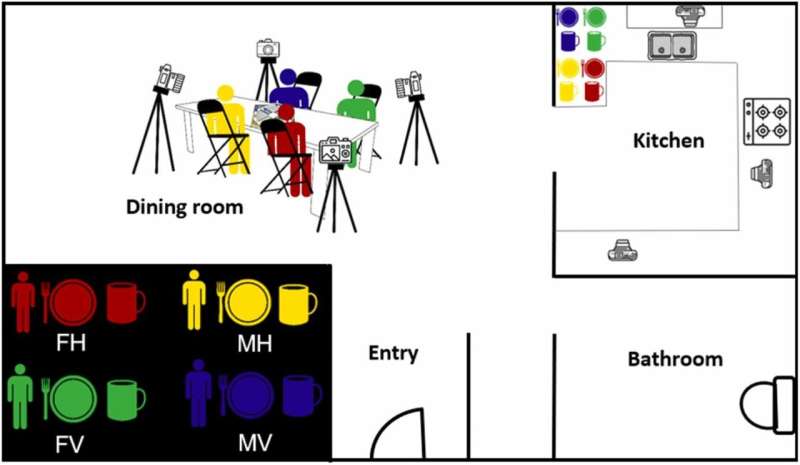This article has been reviewed according to Science X's editorial process and policies. Editors have highlighted the following attributes while ensuring the content's credibility:
fact-checked
trusted source
proofread
Making sense of crime scene DNA patterns

Piecing together the evidence to accurately replicate the movements of a culprit at a crime scene is becoming a more exact science, with new investigations by Flinders University and other experts on various DNA transfer scenarios.
Three new articles in Forensic Science International: Genetics used video recordings and complex Bayesian networks probability modeling to highlight the way human DNA moves within indoor spaces and when collected as evidence at a crime scene.
The lead authors—forensic scientists Dr. Duncan Taylor and Dr. Mariya Goray—say that substantial improvements in the sensitivity of forensic DNA techniques now allow for very small traces of DNA, originating from only a few cells, to be tested and presented as evidence in court.
"The results of these studies may assist with decision-making for exhibit selection or targeting areas for sampling within the home environment," says Dr. Goray, forensic genetics senior lecturer at the College of Science and Engineering.
"In conjunction with previous studies, these findings can be used to help develop activity-level evaluations where questions about whose DNA is conceded, but questions about how it got to the crime scene are not disputed."
For example, social interactions that form the fabric of human behavior, are often brought up in court to explain the presence of a defendant's DNA on an incriminating piece of evidence.
To show how DNA was deposited by four people playing a board game, more than 100 DNA samples were collected from clothing, people and surfaces and the contacts made by the participants. The activities were recorded by multiple cameras, capturing the movements of DNA from a range of contacts made by the people in the three rooms of the house.
The researchers found that duration and number of contacts did not significantly affect the detection of the person contacting the item.
Not only can background DNA from previous contact and individuals' personal shedder status (innate ability to deposit their own cells) appear to play a role, but so can unknown individuals be detected in the majority of samples. This includes indirect transfer of 'wearer' DNA from close associates of those at the scene.
Dr. Taylor, Flinders University lecturer and also Chief Scientist—Forensic Statistics at Forensic Science SA, says complex modeling of site-to-site DNA transfer on an exhibit can be important to consider during an evaluation.
"Using graphical probabilistic Bayesian reasoning, we modeled multiple people's DNA transfer at trace levels between areas of an exhibit to see how often, and how much transfer will occur during routine forensic procedures," he says.
"New research and guidelines on evaluation of forensic findings using activity level propositions are increasingly being used to assist in understanding how to think about casework scenarios that involve DNA transfer, persistence, prevalence and recovery."
A Bayesian network is a graphic model that represents probabilistic relationships among a set of variables.
The research sought to demonstrate what can happen to DNA on an exhibit once collected, and even to demonstrate how human DNA moves and/or is completely removed from indoor spaces where major crimes occurred.
More information: Amy Cahill et al, Where did it go? A study of DNA transfer in a social setting, Forensic Science International: Genetics (2024). DOI: 10.1016/j.fsigen.2024.103101
Monique Zacher et al, Transfer and persistence of intruder DNA within an office after reuse by owner, Forensic Science International: Genetics (2024). DOI: 10.1016/j.fsigen.2024.103130
Duncan Taylor et al, Accounting for site-to-site DNA transfer on a packaged exhibit in an evaluation given activity level propositions, Forensic Science International: Genetics (2024). DOI: 10.1016/j.fsigen.2024.103122
Provided by Flinders University


















